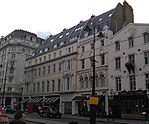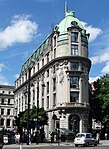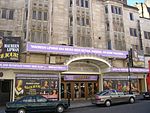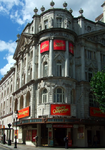Lyceum Theatre, London

The Lyceum Theatre ( ly-SEE-əm) is a West End theatre located in the City of Westminster, on Wellington Street, just off the Strand in central London. It has a seating capacity of 2,100. The origins of the theatre date to 1765. Managed by Samuel Arnold, from 1794 to 1809 the building hosted a variety of entertainments including a circus produced by Philip Astley, a chapel, and the first London exhibition of waxworks by Madame Tussauds. From 1816 to 1830, it served as The English Opera House. After a fire, the house was rebuilt and reopened on 14 July 1834 to a design by Samuel Beazley. The building is unique in that it has a balcony overhanging the dress circle. It was built by the partnership of Peto & Grissell. The theatre then played opera, adaptations of Charles Dickens novels and James Planché's "fairy extravaganzas", among other works. From 1871 to 1902, Henry Irving appeared at the theatre, especially in Shakespeare productions, usually starring opposite Ellen Terry. In 1904 the theatre was almost completely rebuilt and richly ornamented in Rococo style by Bertie Crewe, but it retained Beazley's façade and grand portico. It played mostly melodrama over the ensuing decades. The building closed in 1939 and was set to be demolished, but it was saved and converted into a Mecca Ballroom in 1951, styled the Lyceum Ballroom, where many well-known bands played. The Lyceum was closed in 1986 but restored to theatrical use in 1996 by Holohan Architects. Since 1999, the theatre has hosted The Lion King.
Excerpt from the Wikipedia article Lyceum Theatre, London (License: CC BY-SA 3.0, Authors, Images).Lyceum Theatre, London
Wellington Street, London Covent Garden
Geographical coordinates (GPS) Address External links Nearby Places Show on map
Geographical coordinates (GPS)
| Latitude | Longitude |
|---|---|
| N 51.511556 ° | E -0.11975 ° |
Address
Lyceum Theatre
Wellington Street 21
WC2E 7DN London, Covent Garden
England, United Kingdom
Open on Google Maps










